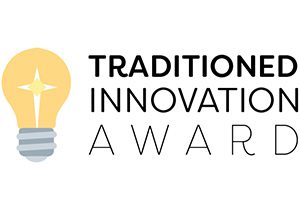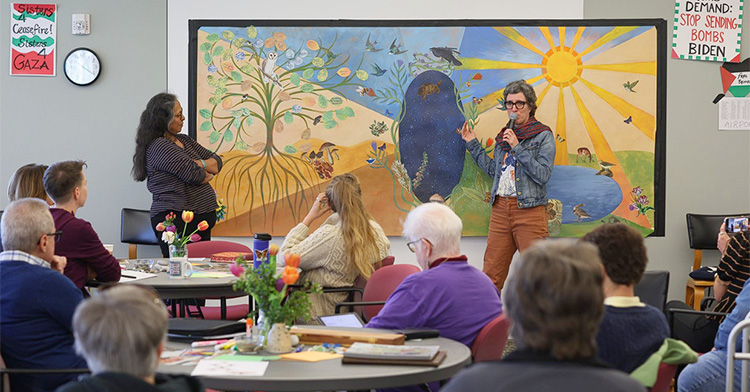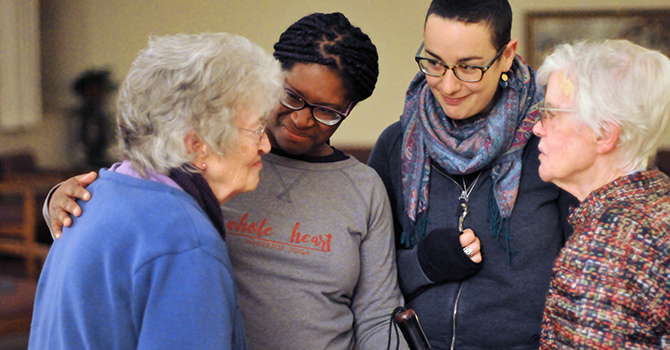In the model of Catholic religious communities, Brittany Koteles sees a lifeline for our society. The radical choice to bond together as a community first and foremost pushes against forces of capitalism and property that prioritize individuals and perpetuate systems of injustice.

A co-founder of an offshoot of Nuns & Nones called Land Justice Futures, Koteles originally came to Nuns & Nones seeking mentorship and found, in the company of religious sisters, deep thinking from different religious communities about how to choose to reject those systems of injustice through how they used their land.
One such nun was Sister Chris Loughlin, who died last year. Key in inspiring Land Justice Futures, which launched in 2021, Loughlin spent decades accompanying religious communities that wanted to think about how to use their land more justly.
“She was a really important expert and elder to us,” Koteles said.
When Koteles and others were thinking about founding Land Justice Futures to continue the work of exploring the just use of land but were unsure about their role, since they weren’t sisters themselves, Loughlin affirmed that there was a lot they could offer as young people also committed to finding more just ways of living in the world.
Koteles spoke with Faith & Leadership’s Chris Karnadi about what land justice means and how Land Justice Futures helps religious communities imagine different uses for their land. The following is an edited transcript.
Faith & Leadership: How did you arrive at Nuns & Nones?
Brittany Koteles: I came to Nuns & Nones as a result of my own personal searching and my own desire for spiritual eldership in my life.
I was drawn to those initial intergenerational conversations and, to me, the sort of blueprint for a way of living otherwise that I saw alive in religious communities. I was really inspired by sisters and heartened to see and spend more time inside this model of women who were really throwing their lot in together and choosing to live alternatively in community.
That’s hard to find in this world, and I think those models of community are so important.
We can’t actually live counterculturally inside late-stage neoliberal capitalism without community. The currents are too strong, both spiritually and economically. It’s too hard to do alone.
The great spiritual wisdom at the core of these communities is that they understand that. So I came to know sisters through the Nuns & Nones meetups, and I started spending more time with them and slowly became more involved, first with Nuns & Nones, the organization, and then became the co-founder of Land Justice Futures, which spun out of Nuns & Nones.
F&L: How did Land Justice Futures start?
BK: Nuns & Nones was founded in 2016, and it was a space of encounter between sisters and seekers across the country who were, I would say, finding common ground around our longing for alternative communities in pursuit of spirit and justice, or alternative communities of spirit in pursuit of justice.
So sisters and seekers were drawn to each other to explore those themes, and many things grew out of that original impulse.
We had small groups that met up all over the country. We had a residency pilot at Sisters of Mercy in Burlingame. We did some organizing together, we took courses together, and one other big thing that grew out of it was Land Justice Futures.
It really grew out of our shared values of climate justice and a parallel reality that the communities that we were spending time with, religious communities, were making big decisions about their land at the same time.
It was clear to us that communities didn’t always feel supported to be as creative or prophetic with the real and time-bound or time-sensitive decisions that they needed to make around property and the divestment of property. So we wanted to help fill that gap.
At the beginning, we were sort of like, “How do we support you to do this?” — not at all trying to start our own organization. That wasn’t the plan or the intention, but it was clear that actually there was an invitation to start something. There was a need for accompaniment from the outside to imagine beyond the bounds of what religious communities were seeing as possible for the future of their lands.
F&L: What is land justice?
BK: We define land justice as centering racial and ecological healing in the way decisions are made about how land is loved, used, owned and governed.
That, to us, has three important parts. First, protecting land from further extraction. Communities are total front-runners in that. And the second piece, often, is regenerating the health of the land. The third piece is expanding equity and access to people who have been most harmed by an extractive economy, and in particular, we focus on Black and Indigenous people.
Pope Francis would talk about it as integral ecology, that the social approach is always an ecological approach and vice versa, in order to go beyond just the conservation of land and think holistically about futures of the land that heal both the ecological harm done by this paradigm and the social harm, which means asking not just what will happen to the land but who gets to care for it and why.
We live in a country where 98% of private land is owned by white people and white institutions. And what we’re trying to do with land justice is re-center the decisions about land in the reality that the extraction of the earth and the hoarding of land and wealth by white European Christians — those realities are very intertwined.
It’s the same paradigm that we’re still stuck in of Euro-Christian dominance that says whoever has the money can do what they want with the land and that white Christians are better than other kinds of people. And so land justice is really an opportunity to, one, understand how that came to be, and then, in that understanding, make different decisions that can bring forth a different future.
F&L: What does Land Justice Futures do?
BK: What we do is we accompany religious communities in specific ways to create a land justice property plan.
One part of that is that we create educational resources to support religious communities to learn about land justice and to imagine more of what’s possible for the futures of their land.
We put out case studies and have conversations and webinars about real examples of how land has been returned to Indigenous stewardship, like how a 100-acre farm was donated by a Methodist minister to a Black farming collective, or examples of how farm workers have regained access and ownership to land.
If you go on our learning platform, you can see that we have all kinds of case studies and examples and knowledge that we are spreading.
It’s like a message that we’re putting out to sisters to say, “More is possible for your land. More healing is possible than the status quo would suggest. Even if you have limitations, even if you have financial parameters, land justice can be a possibility for you.”
The examples show that we can be more creative and collaborative and just in the decisions that we make about land.
The second thing that we do is we have an intensive program called Focus Communities. It’s a two-year cohort-based program where we walk with communities to learn more about land justice, identify potential land justice options on their own property, and start moving toward a land justice property plan with their community.
That’s a much more intensive program that starts with walking with other religious communities who are learning this alongside each other and being a learning community together. And then also, by the end, bringing in technical support and supporting the partnership-building process to actually put land justice in motion.
We have seven communities that are completing their second year, and then we have another nine that just began their first year.
They’re all over. There’s a map on our website that lists them all, but they are mostly in the Northeast and the Midwest, just given that that’s where the most Catholic communities are.
All the communities are Catholic sisters, but within that, there are Franciscans, Dominicans, Sisters of Loretto, Sisters of St. Joseph, Notre Dame.
F&L: Can you share an example of land justice that you’ve seen?
BK: I’ll give you a story that we didn’t have anything to do with the beginnings of, but with that very important caveat, I think it’s a really important story of land justice. And then I could speak to how we support communities at large.
Right now, on a sister-owned retreat center on Long Island, there is a group of Indigenous women who run a regenerative kelp farm — on the retreat center of the Sisters of St. Joseph of Brentwood, New York. It’s called the Shinnecock Kelp Farmers.
The sisters have owned a retreat center there for decades, and that is the ancestral lands of the Shinnecock people. And the bay that holds their name, the Shinnecock Bay, Long Island, is super polluted, because septic systems have totally messed up the ecosystem there.
There’s not a bay on Long Island that doesn’t have dead zones like algae blooms because of overdevelopment and pollution, and the Shinnecock Bay is no exception to that.
These six women wanted to start a kelp farm because of its regenerative properties. Kelp filters 20 times more carbon dioxide than the same acreage of a forest of trees would.
It’s both a kind of growing modern practice for ocean stewardship and an ancestral practice of the Shinnecock. The kelp farmers asked the sisters to use the land, and Sister Joan Gallagher tells this story, she’s like, “Yes, of course we have to say yes to this. This is your land.”
Their story of mutual accompaniment has just been phenomenal. I could go on and on about it. We have a little interview on our website, and there’s all kinds of stuff about them on the internet that you can dig into more if that’s of interest.
The Sisters of St. Joseph in Brentwood joined as one of our first focus communities. They already were running the regenerative kelp farm off their land, but they don’t know and they’re still discerning: This wonderful thing that’s happening right now, what does it look like in the future, and what does it look like after we’re gone?
How do we make sure we can support this to happen in the long term? And how are we being transformed by this relationship and this collaboration and the leadership of these Indigenous women? How are we being transformed by that? How are we letting this transform the way we’re thinking about property planning?
A lot of communities that we work with are not as far along. They don’t have an Indigenous-run kelp farm already happening on their property. That’s pretty dreamy, pretty rare, as you can imagine.
We’re only two years old, so our oldest cohort is in their second year. We’re very early on in this work, but I would say a couple of ways that our support looks like are, one, helping communities expand their search for future partners in ways that don’t exacerbate racial inequity in that process.
And we help them think through their hopes and dreams for the future of their land in accordance with or kind of woven together with their values of racial and ecological justice.
A lot of times, these decisions can be burdensome; they take a lot of capacity. There are a lot of factors going into these decisions. And so a lot of times, the default in dealing with property decisions is that they fall into this default real estate partnership search or listing or you look for partners in the same way that most property deals might be made.
And that’s going to exclude people who might not be able to compete in the market, but if they had two years to fundraise in collaboration with the community or if they could secure, with the community’s support, a 0% interest loan — there are all these hacks and ways that we can crack open the “normal” real estate process.

Traditioned Innovation Award Winner
Leadership Education at Duke Divinity recognizes institutions that act creatively in the face of challenges while remaining faithful to their mission and convictions. Winners received $10,000 to continue their work.


















